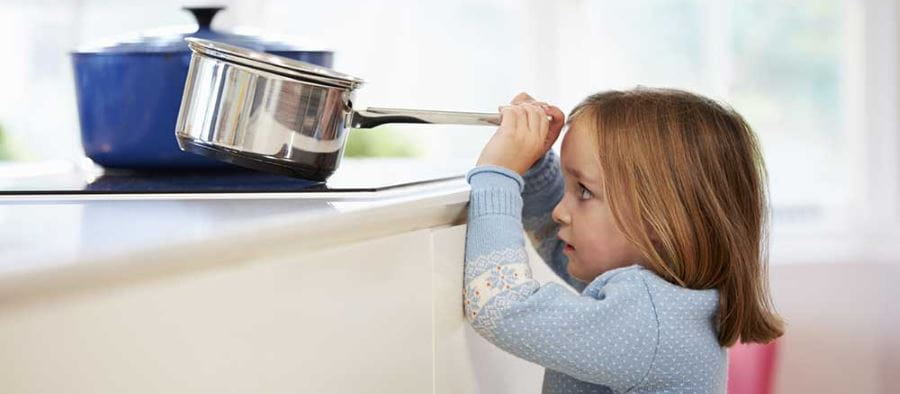
Burns can happen anywhere and from a variety of causes. According to the Fiona Wood Foundation, 200,000 people suffer burns annually across Australia, and these injuries cost the community more than $150 million per annum.
Here in WA, 568 children a year were admitted to Perth Children's Hospital for burns and scalds in the 2012-22 financial year. Among adults, more than 60% of burn injuries between 2015-19 involved men.
There are three types of burns:
- First-degree (superficial) burn — redness, mild swelling, and pain.
- Second-degree (partial thickness) burn — deeper injury; blisters develop.
- Third-degree burn — deeper destruction; skin layers are destroyed.
How to prevent different burns
Burns can happen in a range of environments, from your home to your workplace, while camping or even when visiting friends.
Fires
Locations of fires can include: in the kitchen, at BBQs, when out camping, bonfires, or within the workplace. It’s important to assess the environment and equipment accordingly and to always have a plan in place should the fire get out of control.
Get a permit if necessary, become familiar with emergency fire evacuation plans and remove flammable material.
For home heating, use wood burning fires carefully and teach children to stay away from them as well as space heaters.
Store matches and lighters in a locked cabinet, away from children.
Electrical
Electrical burns can be caused from electrical appliances and outlets in and out of home as well as lightning. Shocks can occur from misuse or faults.
To avoid this, steer clear of appliance use around water, always follow the instructions and call your electrician if necessary. It’s important to cover electrical outlets and remove electrical devices around children.
Education around appliance use and the nature of lightning helps kids to better understand the dangers.
Hot Fluids
These burns can be from oils, food and water in or out of the home. Often, these types of burns happen in a kitchen or bathroom environment.
To help keep little ones safe, turn the handles of kitchen pots and pans toward the side of the stove, or use the back burners.
Use cool-water humidifiers or vaporizers. If you use hot-steam vaporizers, keep them out of the reach of children.
Chemical Burns
Chemical burns can be caused from solutions in the home, outdoor or work environment. Things that can cause chemical burns include bleach, ammonia, gasoline, drain cleaners, paint thinners as well as many other substances.
When using chemicals, be sure to never leave the solution unattended and have fresh water close by in case contact is made.
These should all be concealed and out of child reach.
If yourself, a family member, colleague or friend suffered a burn would you know how to treat it?
The treatment for all types of burns is the same, and you should ensure you follow the DRSABCD procedure.
Here's a handy guide you can follow to assist in seeing the best possible outcome from a burns injury.
Ensure safety for rescuers, bystanders and the victim.
- Do not enter a burning or toxic atmosphere without appropriate protection.
- Smother any flames with a blanket
- Move away from the burn source to a safe environment as soon as possible
Stop the burning process
- Stop, Drop, Cover and Roll (where appropriate)
- Apply cool running water to the burn for 20-30 minutes. This will provide pain relief and minimise tissue loss. (Relevant to ALL burn types)
- Follow this with covering the burn with a sterile gauze bandage or clean cloth
Always
- Assess the adequacy of the victim's airway and breathing.
- Check for other injuries.
- Call for an ambulance.
For all types of burn, DO NOT:
- Peel off adherent clothing or burning substances.
- Use ice or ice water to cool the burn as further tissue damage may result.
- Cover the burn directly with fibrous material like blankets and towels that can stick to the burn.
- Break blisters.
- Apply lotions, ointments, creams or powders other than hydrogel (Burnaid or similar)
Why Learn first aid and CPR?
This information is NOT a substitute for first aid training. Royal Life Saving Society WA recommends that everyone is trained in first aid and CPR.
Learning first aid can save lives. People die every day from sudden cardiac arrest, because family members, friends, and bystanders don't know how to respond effectively.
Cardiopulmonary resuscitation (or CPR) is easy to learn, and our training is available all over the Perth and regional areas of Western Australia to instruct people how to deal with cardiac arrest, and many other life threatening emergencies. Learning first aid is a simple way to save a life.
You can prepare yourself to act in an emergency by attending one of our many first aid training courses. Remember, 'everyone can be a lifesaver'!
